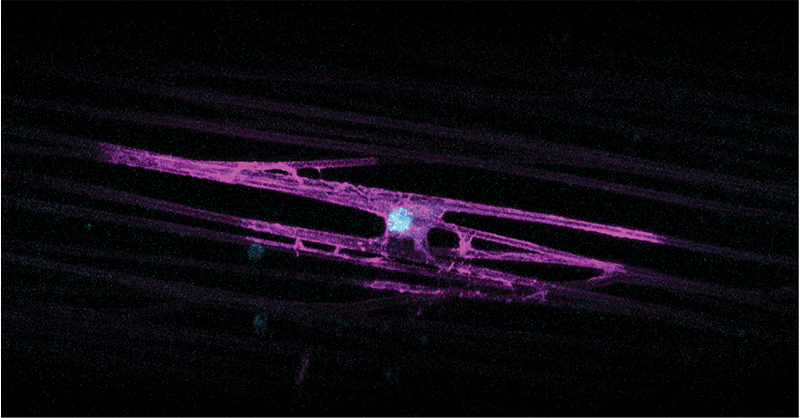OHSU researchers discover a gene that helps cells sense mechanical forces and plays a key role in how myelin forms during development. This image shows brain cells called oligodendrocytes — the protective coating around nerve fibers in the brain and spinal cord from a mouse model — growing in a lab and wrapping around tiny nerve fibers. The myelin they produce is shown in pink, and their nuclei are shown in blue. (OHSU/Amanda Senatore)
Researchers at Oregon Health & Science University have identified a gene that plays a crucial role in the brain’s ability to form the protective layer around nerves known as myelin, potentially opening new doors to treatments for a rare childhood disorder and more common diseases such as multiple sclerosis.
The study, published today in the Proceedings of the National Academy of Sciences (LINK), shows that the gene transmembrane protein 63A, or TMEM63A, plays a major role in infantile hypomyelinating leukodystrophy 19, or HLD19, a rare genetic disorder that affects brain development in early childhood. Children with the condition often show delayed development, coordination problems and other neurological symptoms due to insufficient myelin, the protective layer around nerve cells.
In the new study, researchers used mouse and zebrafish models to show that inactivating the TMEM63A gene leads to early myelination defects that closely mimic symptoms seen in children with HLD19. This study also helps explain how most of the gene changes that cause HLD19 might stop the gene from working properly.

Swetha Murthy, Ph.D. (OHSU)
“The hope is that if we understand how this gene facilitates myelination, then we can develop therapies that restore or promote myelin formation — not just for this rare disorder, but also for diseases like multiple sclerosis,” said senior author Swetha Murthy, Ph.D., assistant scientist at the OHSU Vollum Institute.
“Our study identifies TMEM63A as a crucial regulator of myelin formation in the central nervous system,” Murthy said. “This discovery not only deepens our understanding of HLD19 but also provides powerful new models to guide future treatment strategies for related neurological disorders.”
Murthy became interested in the gene after early reports linked it to children with HLD19.

Kelly Monk, Ph.D. (OHSU)
She was intrigued by the gene’s role as a mechanosensitive ion channel — a protein that helps cells respond to mechanical cues. She collaborated with Kelly Monk, Ph.D., co-director and senior scientist at the Vollum Institute, and Ben Emery, Ph.D., the Warren Distinguished Professor in Neuroscience Research and associate professor of neurology in the OHSU School of Medicine.
Both Monk and Emery research the role of myelin, albeit from different angles.

Ben Emery, Ph.D. (OHSU)
“It’s been known for a long time that myelinating cells use physical cues such as the size of individual nerve fibers when they decide where to form their myelin, but how they sense those cues has remained a mystery,” Emery said. “Swetha is an expert in the proteins that help cells sense the physical word around them, so Kelly and I were extremely excited to be able to work with her on this problem when she was recruited to OHSU. The fact this collaboration helps us understand the basis of an important childhood disease makes it even more gratifying.”
While its role in myelin production was previously unknown, the new study shows that TMEM63A is essential for proper development of the nervous system.
“This gene senses mechanical pressure — a type of biological signal that has been overlooked in the context of myelination,” Murthy said. “We’re now showing that these mechanical signals may be essential for myelin-producing cells to properly wrap nerve fibers. This gives us a brand-new angle for understanding and potentially treating demyelinating diseases.”
Myelin is essential for fast, efficient communication between nerve cells. While demyelination in infants causes leukodystrophies like HLD19, similar processes underlie multiple sclerosis, a disease that affects more than 2.8 million people worldwide, according to the National Multiple Sclerosis Society.
“We’ve shown that this gene’s effect on myelin is not only real — it’s conserved across species, including zebrafish and mice,” Murthy said. “That gives us powerful models to further study the disease and screen potential drug therapies.”
The team now plans to dig deeper into how the gene regulates the complex cellular machinery behind myelin formation. This includes identifying other proteins that may work alongside it to help myelinating cells sense the physical environment around them in the brain.
“We’re at the beginning of a new research direction,” Murthy added. “We want to understand the exact steps in myelin formation where this gene plays a role — and whether that process can be targeted with drugs. If so, it could reshape how we treat both rare leukodystrophies and more common conditions like MS.”
The study is the result of a unique collaboration between the Murthy, Monk and Emery labs at OHSU, combining expertise in molecular biology, genetics, model organisms and physiology.
“This kind of work is only possible in a highly collaborative environment like OHSU,” Murthy said. “Our team brought together different perspectives to tackle a challenging and meaningful problem. It’s incredibly exciting to think about the long-term impact this could have on patients.”
In addition to Murthy, Monk and Emery, OHSU co-authors include: Julia Halford, Ph.D., Amanda Senatore, M.S., Sage Berryman, B.S., Antonio Muñoz, B.S., Destinee Semidey, B.A., Ryan Doan, Ph.D., Adam Coombs, B.S., Katie Emberley, B.S., and Brandon Noimany.
This research was supported by the McKnight Endowment Fund for Neuroscience, the OHSU Silver Family Foundation, The Laura Fund, and the National Institute of Neurological Disorders and Stroke, of the National Institutes of Health, under award number R01NS120651. The content is solely the responsibility of the authors and does not necessarily represent the official views of the NIH, or any other funders.
All research involving animal subjects at OHSU must be reviewed and approved by the university’s Institutional Animal Care and Use Committee, or IACUC. The IACUC’s priority is to ensure the health and safety of animal research subjects. The IACUC also reviews procedures to ensure the health and safety of the people who work with the animals. The IACUC conducts a rigorous review of all animal research proposals to ensure they demonstrate scientific value and justify the use of live animals.
